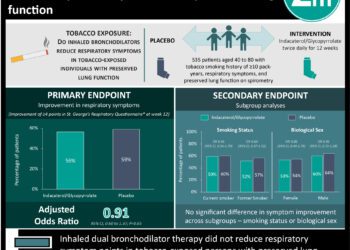The effects of viral respiratory tract infections on neonatal care
1. Amongst infants in the neonatal intensive care unit (NICU) with viral respiratory tract infections (VRTIs), 51% required additional respiratory support.
2. When compared to controls, case subjects with VRTIs had a longer hospital length of stay and twice as many were sent home with an oxygen requirement.
Evidence Rating Level: 3 (Average)
Study Rundown: It is known that infants in the NICU often require intense respiratory support. These infants are often at high risk of developing respiratory illness simply by being in the NICU. In fact, VRTIs cause severe morbidity after these infants are discharged from the NICU. Authors of this study aimed specifically to identify the adverse effects that VRTIs have on neonates during their NICU admission. Results of this study indicated that among VRTIs in NICU infants, 74% of them were rhinovirus. Furthermore, 51% of all infants with acquired nosocomial VRTIs required additional respiratory support, they had a longer hospital stay, and twice as many went home with an oxygen requirement. In-hospital care costs increased significantly in infants that acquired VRTIs during their NICU admission. Beside the inherent limitation of a retrospective study, another limitation was that only symptomatic infants were screened; if screening occurred in asymptomatic infants, the incidence of VRTIs may have been higher. In addition, data in this study was restricted to tertiary care NICUs, thus limiting its generalizability to other NICUs. Nonetheless, these findings should encourage providers to consider strategies for decreasing nosocomial infections in the NICU, such as limiting visiting hours, especially when the viral load in the community is high.
Click to read the study, published today in Pediatrics
Relevant Reading: Human Rhinovirus and Disease Severity in Children
In-Depth [case-control study]: In this retrospective matched study, data from July 2007 and July 2013 was retrieved. Among 7995 NICU admissions, 275 met inclusion criteria, 92 case subjects and 183 control subjects. Case subjects were identified as NICU infants with signs and symptoms of VRTIs and PCR-positive viral DNA in airway secretions. Control subjects were matched according to gestation, center in which they received the majority of their care, and birth within 6 months of case subject to minimize variations in care over time. A total of 95 VRTIs were diagnosed via PCR, with rhinovirus being the dominant pathogen (74% of cases). Case subjects were found to have an increased need for ventilation, with a median of 7 days vs. 2 days in control subjects (p<0.001). They also required significantly more continuous positive airway pressure at a median of 18 days compared to control subjects (p=0.026). Case subjects’ hospital length of stay was significantly longer than controls (76 vs. 41 days, p<0.001) and when they were discharged from the hospital, 37% of case subjects (vs. 17.5% of controls) required home oxygen (p=0.002). When calculating care costs, case subjects amounted $71,861 per patient whereas control subjects came up to $32,057 per patient.
Image: PD
©2015 2 Minute Medicine, Inc. All rights reserved. No works may be reproduced without expressed written consent from 2 Minute Medicine, Inc. Inquire about licensing here. No article should be construed as medical advice and is not intended as such by the authors or by 2 Minute Medicine, Inc.



![Oral amoxicillin as effective as injectable benzylpenicillin-gentamicin for infants with infection in which referral not possible [AFRINEST Trial]](https://www.2minutemedicine.com/wp-content/uploads/2015/04/NOVAMOXIN_antibiotic-350x250.jpg)



